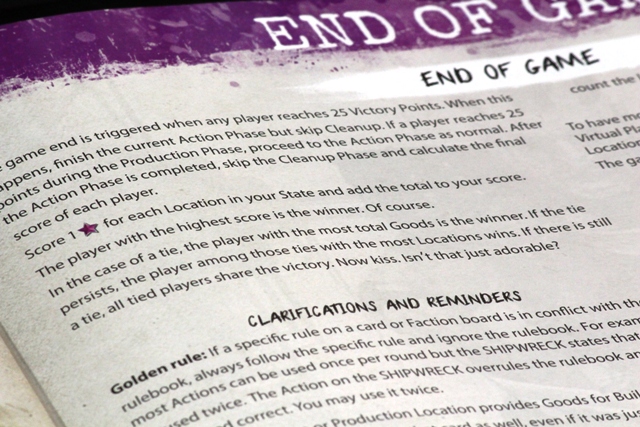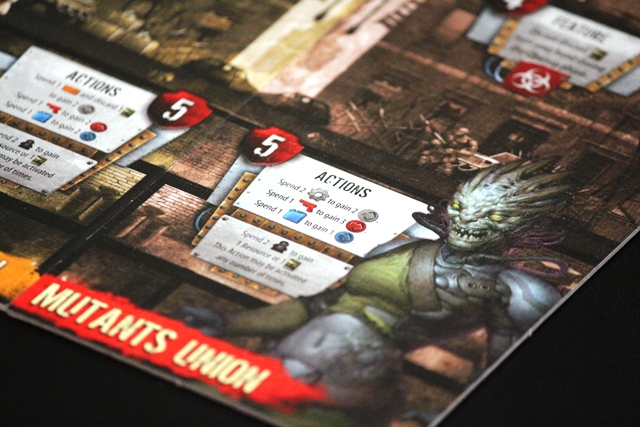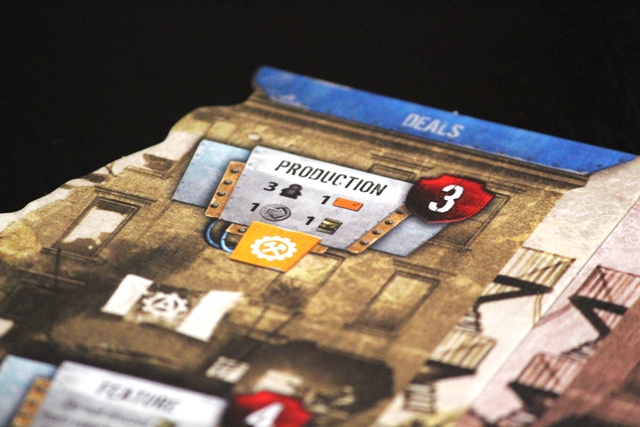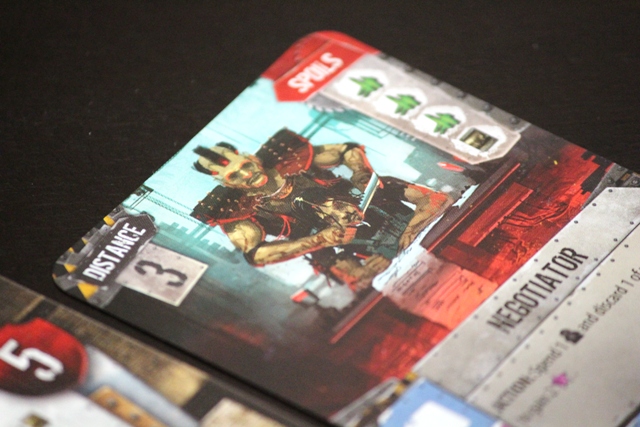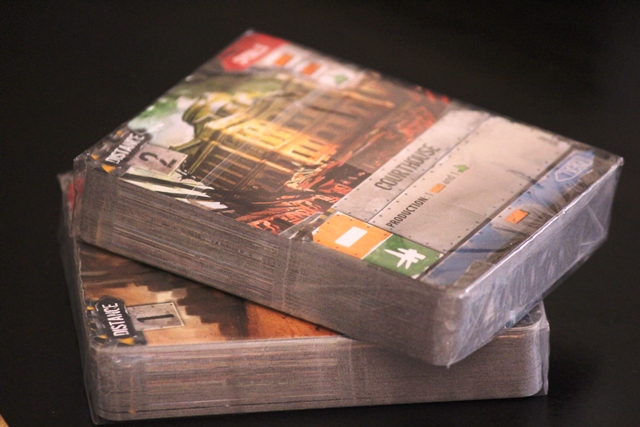51st State Master Set – Review
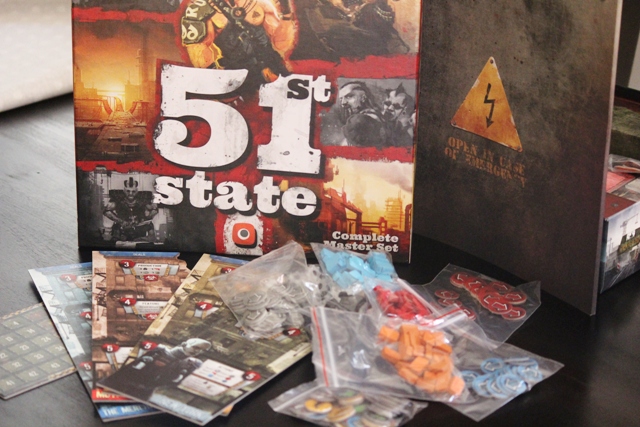
What is it? From the man who brought you a game about budding civilisations based on a game about the end of civilisation, comes a game about the end of civilisation based on the game about budding civilisations.
Imperial Settlers is a game that unlike most of its brethren gathering dust on my shelves, actually sees a fair bit of play. For those who may not know, IS is essentially a rethemed and retweaked version of one of Ignazy Trzewiczek’s earliest successes called 51 State. No, not the 51st State in the title of this review, although they do share the same universe. 51st State, that is, not Imperial Settlers. Yes, I am as confused as you are. But let’s power on and hopefully we can all make sense of this together. And I haven’t even mentioned The New Era either.
Right, so Imperial Settlers performed pretty well for Ignazy and Portal Games, it’s still seeing expansions being produced and currently languishes in the mid 90s on Boardgamegeek’s Top 100, which is no small feat. Aside from fine tuning an existing design, what powered IS’s fortunes was the introduction of separate faction decks. Whilst 51st State also had different factions, cards were all played from one central deck. Naturally this made it easier for Portal to produce expansions for IS, but it also allowed players to latch on to faction decks that suited their particular play style, or to formulate unique card combinations.
So when it was announced that Ignazy was going to be re-implementing Imperial Settlers in its original 51st State setting, let’s just say a fair number of people experienced the loud dinging of hype meters hitting maximum elevation. But it also raised a number of questions: would the new version do enough to distinguish itself from both IS and the original 51st State? What would the impact on Portal be of running two very similar product lines concurrently?
As we tallied up victory points at the end of our first game of 51st State Master Set, my initial response was that I preferred Imperial Settlers. This new iteration was certainly a great game and I enjoyed it thoroughly, but I missed the experience of having my own unique faction deck with a style and function different from anyone else. And then I played 51st State again. And then again. And then when Stuart recently went on honeymoon, I asked if I could borrow his copy. And then I promptly played it another half dozen times.
Is it better than Imperial Settlers? Well, I honestly don’t think that’s an important question to answer. If you already own Imperial Settlers, 51st State is absolutely different enough to warrant owning it as well. And if you don’t own Imperial Settlers, your choice is likely to come down to which theme you prefer and how sold you are on the idea of faction specific decks. And if you really want to know, I’m afraid I’m going to disappoint you by taking the standard parental default – I love both my children equally. But rest assured, 51st is good. Boy, is it good.
Shiny and Chrome
51st State is set in a post-apocalyptic universe of Neuroshima that happens to also be shared by the Neuroshima Hex series of boardgames. Originally a Polish tabletop RPG system, it’s mainly inspired by the Mad Max, Fallout and Terminator themes, and describes a mid-21st century United States caught in the aftermath of a nuclear war. Contrast that with Imperial Settlers and its Roman, Barbarian and Egyptian etc factions, and it’s evident that 51st State is perhaps less likely to be embraced by family members. Forget the somewhat quaint stylings of the IS artwork, the world of Neuroshima is a distinctly unwelcoming place. Burnt-out churches, masked assassins and tattooed maniacs with fire blazing in their eyes, this is a world as likely to have you impaled upon a rusted machete as it is swallow you alive in a desert of endless sand. Conversely, if Imperial Settlers’ style felt at odds with what can be a very nasty game, you’ll feel right at home in the Neuroshima setting.
I’m not going to go through a detailed explanation of how the game works, the basics remain largely identical to Imperial Settlers which you can read about here, or alternatively you can watch Rodney’s always excellent video explanation. So if the basics are similar, what aside from theme sets them apart? Ironically, Imperial remains the meaner of the two, but I’ll come back to that later. Imperial is also the more generous of the two, which I suppose it actually in keeping with their respective themes. In IS, whether you are Roman or Japanese, the earth brings forth resources aplenty for you to build you locations, whereas Neuroshima’s blighted landscape makes scrounging for every drop of oil a struggle.
And it’s not just the earth’s miserly nature that makes building locations more difficult. Two logs may build you a Watchtower in Imperial, but 51st State forces you to go a step further – generally locations can only be built using what the game refers to as Contact tokens, and the same is true for making deals and for razing. How does one obtain these Contact tokens? By exchanging the resources you generate, such as Oil or Guns. Essentially what’s happening is that 51st State has this duel economic engine requirement, forcing you to adapt to balancing two separate resource streams.
Then of course as I’ve already mentioned, is the lack of faction decks. The game still implements a degree of asymmetry in that the faction boards both generate and utilise resources in varying quantities. The Mutants Union for example generates 1 Gun resource each turn whilst the Appalachian Federation generates 1 Brick instead. The Mutants Union can also exchange 1 Gun for 3 red Contact tokens (which are used for razing), but exchanging Cogs for grey Contact tokens (used for building locations) is more costly for them than for New York. But aside from that, drafting and drawing cards is all done from a shared deck.
And whilst on the face of it you’d think surely having separate faction decks offers greater variety and well, fun, it’s important to note that one of Imperial Settlers’ biggest criticisms is the potential for an imbalance between factions. Many will argue that certain factions are perhaps easier to play than others (in fact even the game will tell you to only play the Japanese once you’re experienced) and perhaps more importantly, that it’s easier to win playing certain factions. A common pool of cards removes this potential pitfall and certainly makes the experience feel like a more genuine test of wits.
The last major difference is how the games handle that last bend as you hurtle toward the finish line. Imperial Settlers adopts the limited round formula, as in the game finishes at the end of the 5th round, whereas 51st State takes the approach of signalling the final round when a player reaches 25 victory points. In theory, this means a game of 51st could take seven or eight rounds, but in practice we’ve found that if anything it’s actually quicker to play. This just adds another layer of strategy as racing to trigger that final round becomes a viable path to victory. If the reaction to the same end-game mechanic in Scythe is anything to go by, this particular choice is a fairly divisive one. However, what I appreciate in this instance is that chasing the race option can backfire very easily. You need to pay close attention to what your opponent could still do before that last round ends, and I’ve seen what was assumed to be a comfortable 15-point lead disappear. Racing to 25 points in all likelihood means you haven’t necessarily built the most robust victory point engine, eking out 2 and 3 VPs where you can. If your opponent has spent three turns lagging behind but generating a lot of resources, chances are their last turn is going to be a heck of a lot more fruitful than yours.
Yeah…feels like hope
So what’s to love? I said earlier that 51st isn’t as mean as IS, and what I meant by that is that razing your opponent’s locations will happen far less frequently in 51st. It’s more costly to raze, which makes the action more a surgical strike and less carpet bombing. Sure, IS can be played without any razing whatsoever, but if you choose to you can mess with your opponents’ production without giving the action much thought. And yet oddly, we found 51st felt more interactive. This is partly due to the existence of open production locations which can be used by any player at a cost to them and a boon to the locations owner, but that race to 25 points also means you’re paying far more attention to your opponent’s tableau. The shared deck also adds somewhat to the level of tension, as you can no longer rely on your Faction deck providing you with the locations you desperately need.
The addition of the Contact token system is probably my favourite. I found the trickiness of balancing the generation of resources to activate locations and yet also needing to acquire Contact tokens to construct, make deals or raze cards fascinating and engaging. It does mean that your strategy needs to be informed by the faction you’re playing, for example the Mutants Union’s strength is generating utilising gun resources, which in turn means it’s easier for them to raze cards from hand or an opponent’s locations.
If there is a negative it’s perhaps that, like Imperial Settlers, 51st is best as a two-player game. Sure, it works at 3 and 4 and I’d be happy to play at those numbers, but it shines best as a duel. Not only does it play quick enough at 2 to warrant multiple rematches in the same session, but as a contest of wits everything clicks in a way that’s subtly absent at higher counts. I’m sure I may have had more complaints had I played the original. I could see players potentially grumble that certain cards are perhaps too similar, differing only in incremental VP rewards for the same resources, but this didn’t bother me at all. There are two ‘expansions’ included in the game, but these both add more of the same as opposed to introducing new mechanics or twisting existing ones. It’s also difficult to recover from a poor first round, especially if the card gods frown upon you and production locations are scarce.
It may be little too soon to compare potential expansions for 51st to the existing ones for Imperial, but I still feel it’s important to point out that as things stand, Imperial has enjoyed a run of excellent expansions – if variety is an important factor in your purchase decision. There are additional Faction boards available for 51st, but it will only see its first proper expansion next year in the form of Scavengers, which promises the addition of a new mechanism as well as new locations.
Like all engine-builders, the greatest appeal of 51st State comes in learning to master synergies, in tweaking every part of your creaking ancient machinery until those ear-splitting clanks become a whir of well-oiled perfection. Everyone loves an engine that purrs as sweetly as a ’65 Ford Mustang, but the enjoyment should come from the restoration process as much as the final result. And that’s where 51st State won me over. Watching your locations churn out victory points in that last round is most pleasing indeed, but the true joy is to be found in getting there.

Pros:
- Excellent balance
- Contact mechanism elevates strategy
- Excellent theming
- Race to 25 points
- Tight scoring
Cons:
- Not really a ‘Master Set’
- Boxed expansions don’t offer enough variation
- Very difficult to recover from a poor first round

